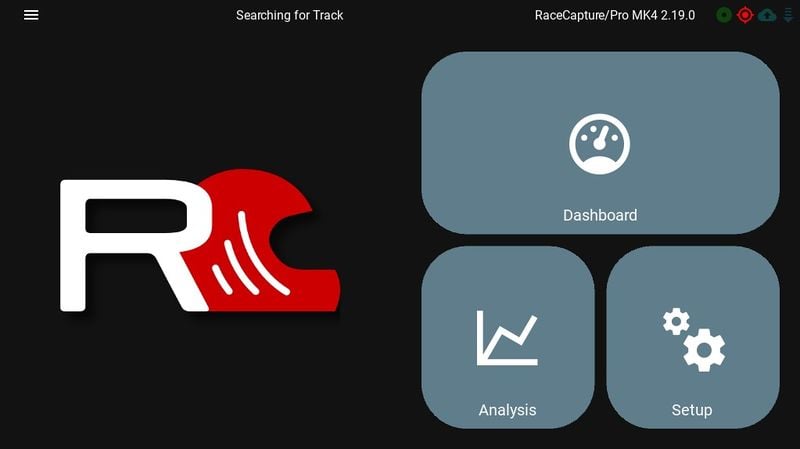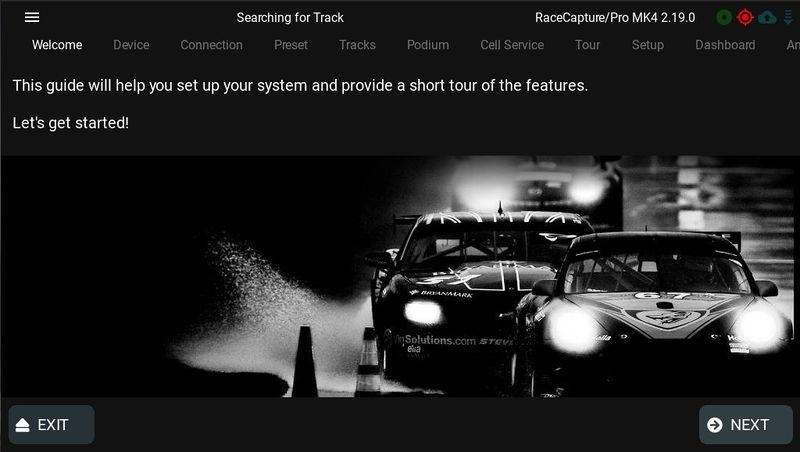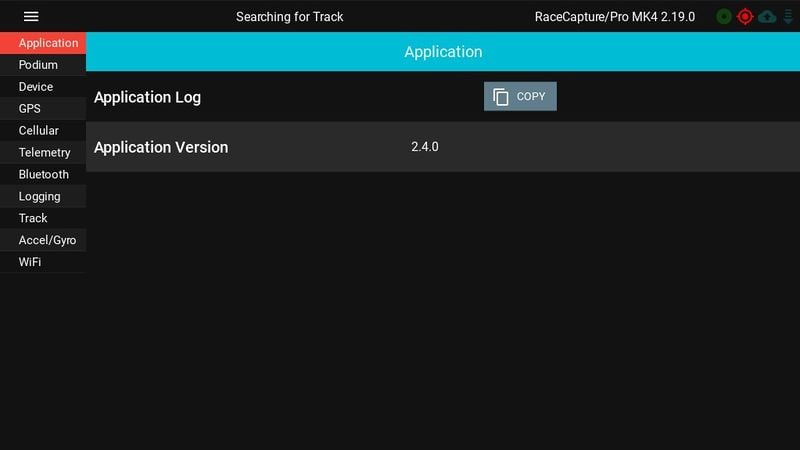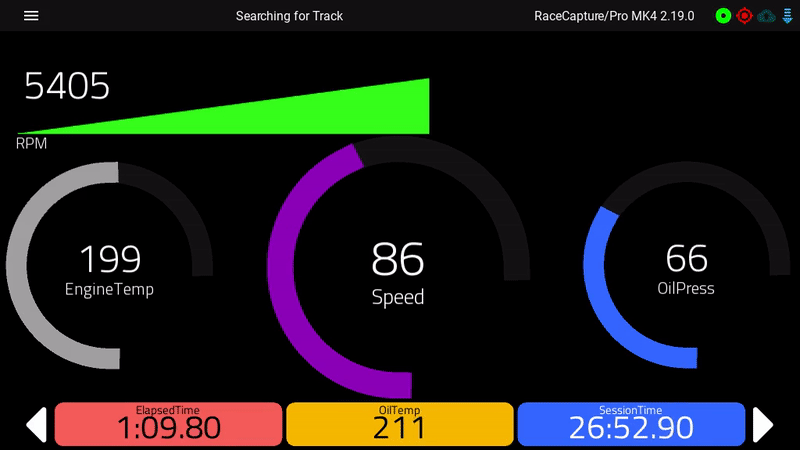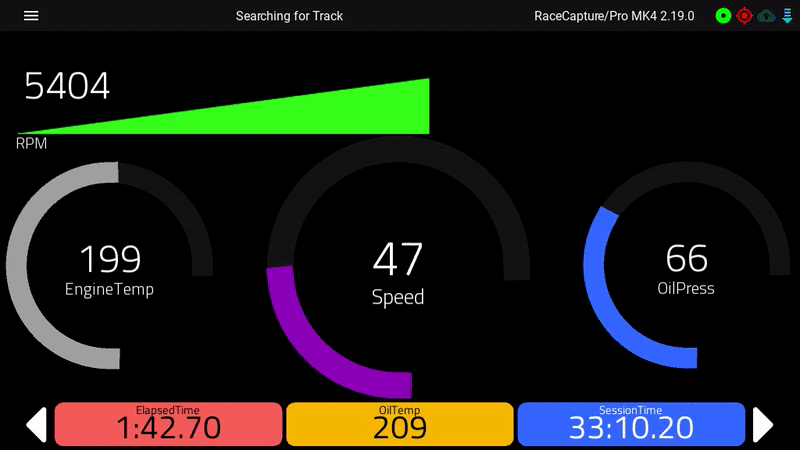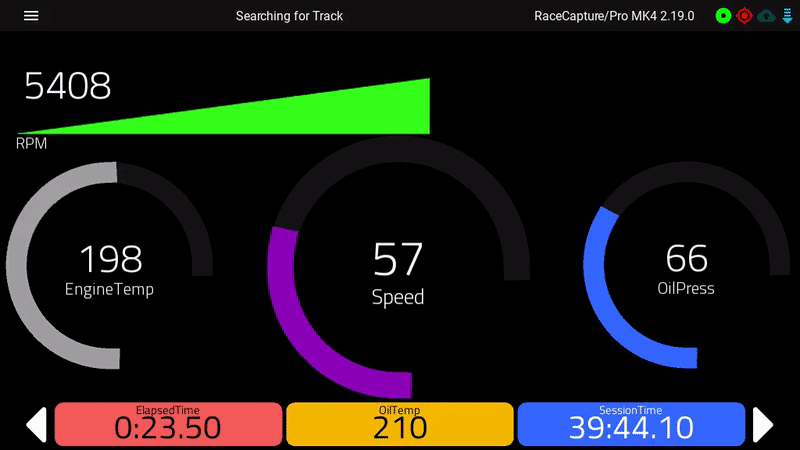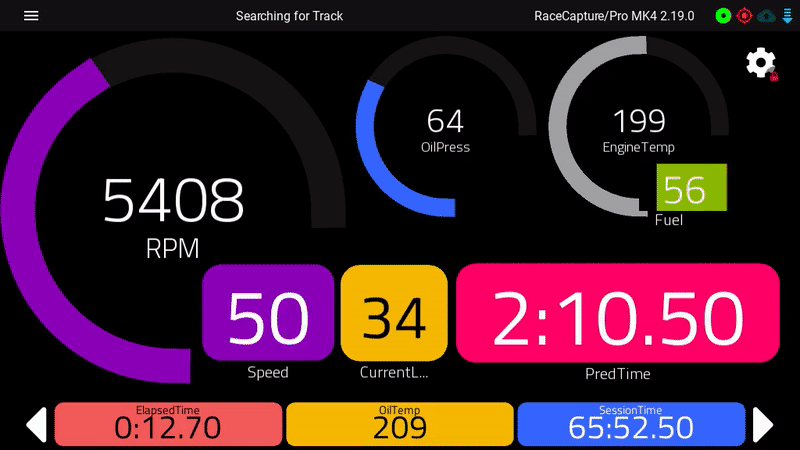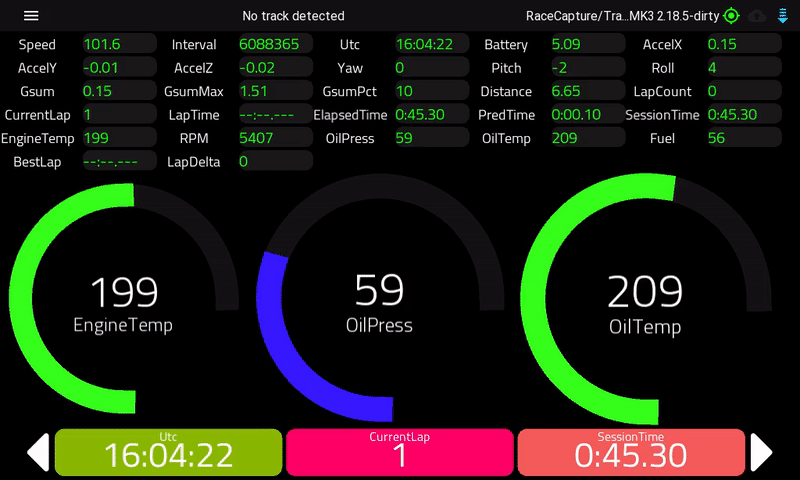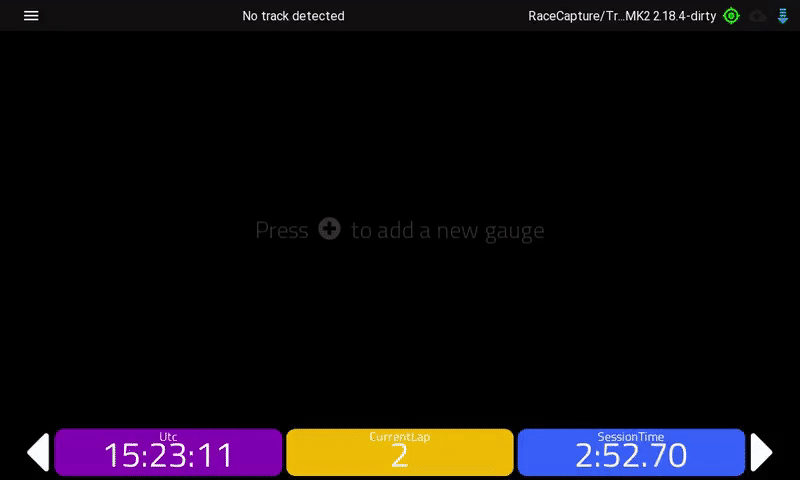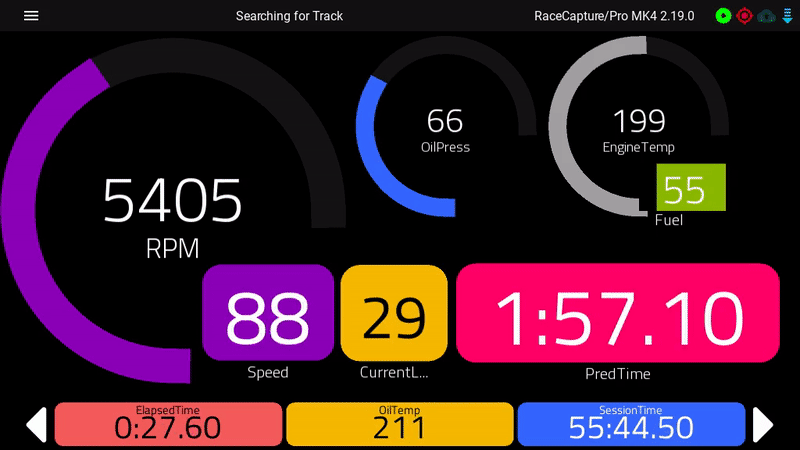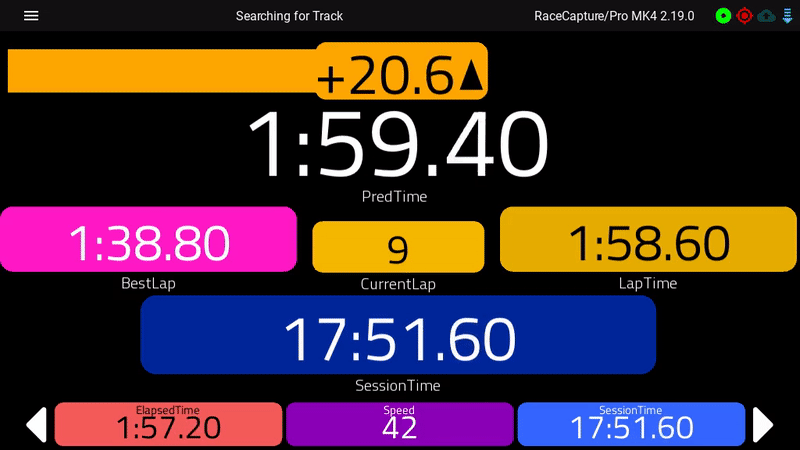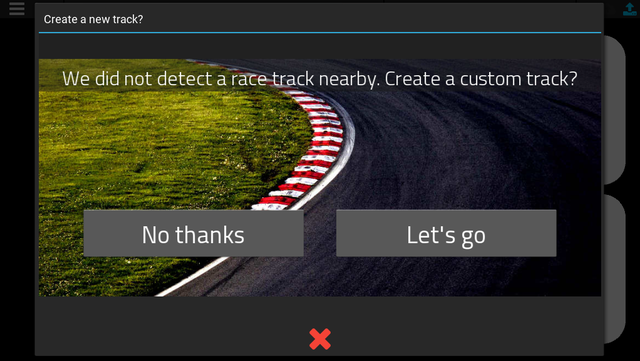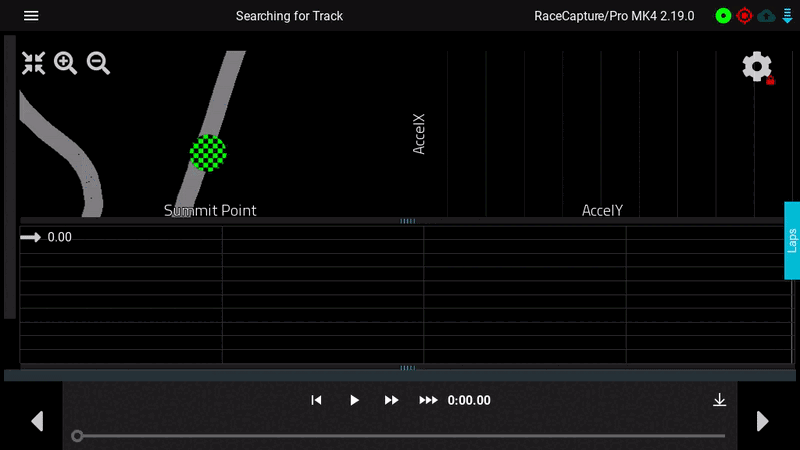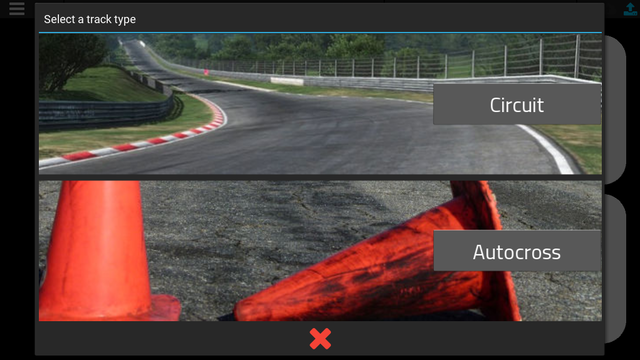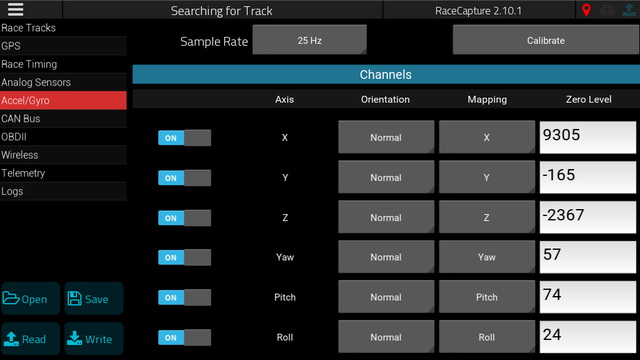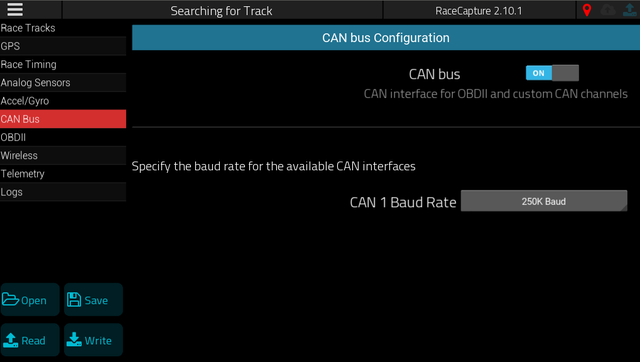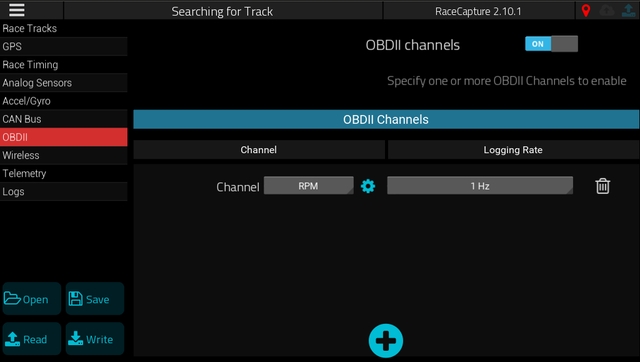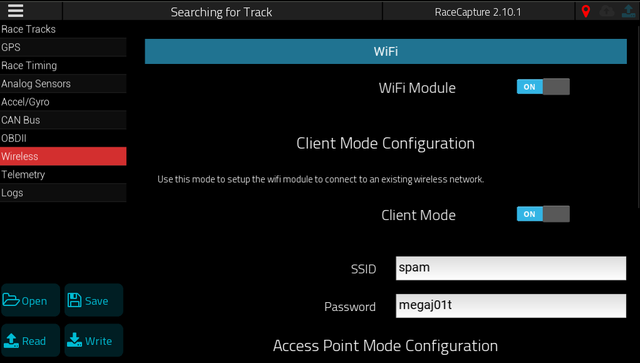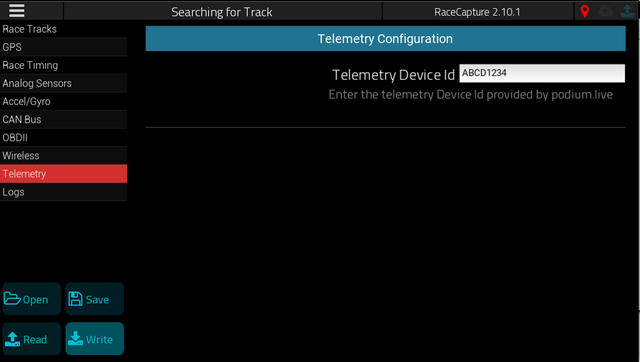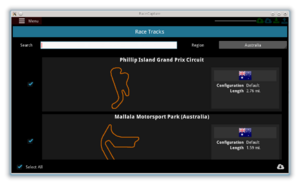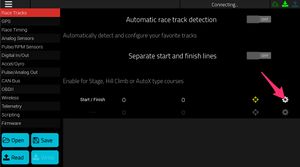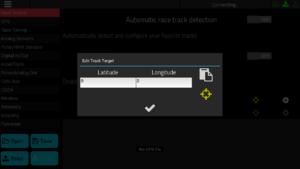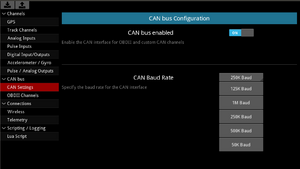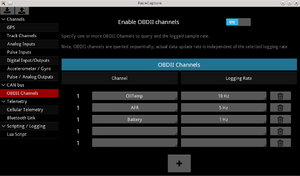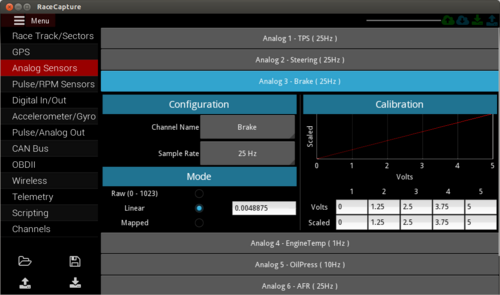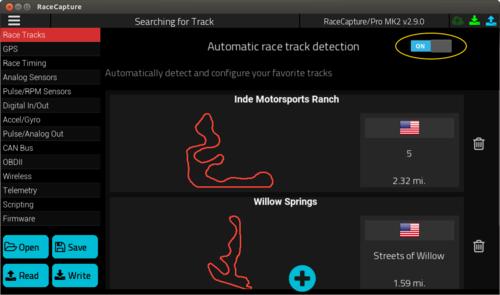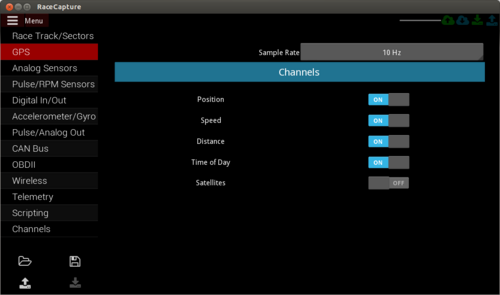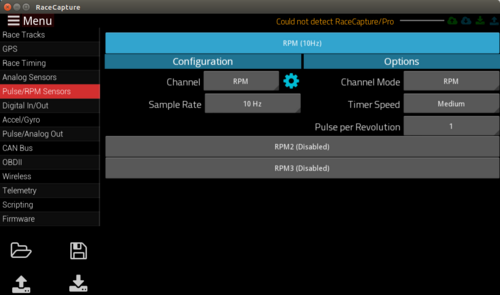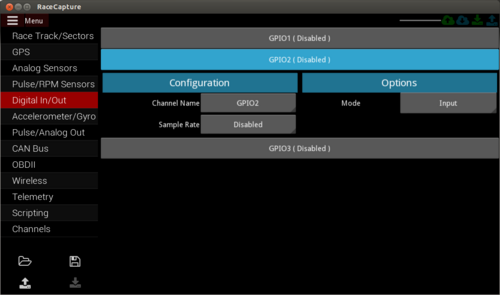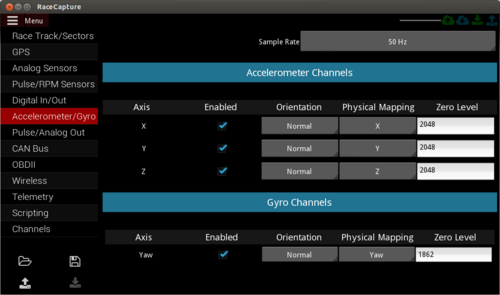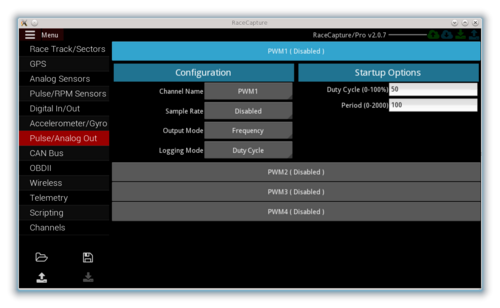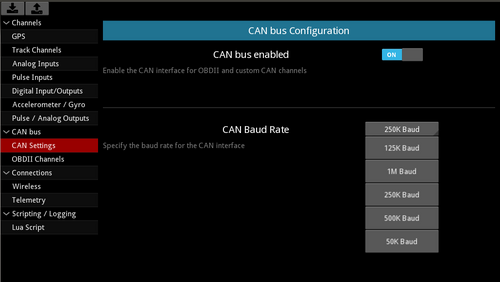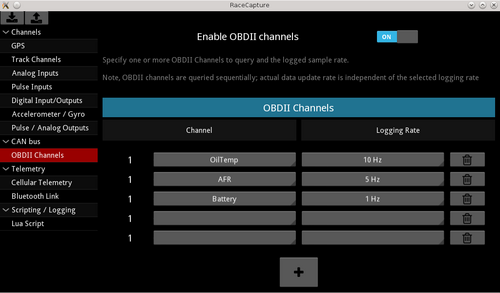RaceCapture App User's Guide: Difference between revisions
No edit summary |
|||
| Line 86: | Line 86: | ||
=Analysis= | =Analysis= | ||
RaceCapture will automatically record your session | The RaceCapture app will automatically record your session when triggered by the threshold you configure under '''Setup / Automatic Control'''. | ||
* '''Note''': The system default is to trigger on Speed | |||
To view the data, enter the '''Analysis''' mode and load an existing session. The session will be automatically named with the local track or with a timestamp. | |||
You can load a session by pressing the (+) button at the bottom of the pop-out list of laps, or by pressing the gear icon on the dashboard and selecting Sessions. | |||
[[image:racecapture_app_analysis_load_session.gif|800px]] | |||
==Reviewing Laps== | ==Reviewing Laps== | ||
If the data contains lap times, the laps will be shown in the dropdown list on the right. Select the laps you wish to compare; | If the data contains lap times, the laps will be shown in the dropdown list on the right. Select the laps you wish to compare; up to 4 laps can be compared at once from the same session or different sessions. | ||
==Navigating data== | ==Navigating data== | ||
===Cursor across line chart=== | |||
Swipe across the line chart to correlate different points with the position on the track map. | |||
===Playback Control=== | |||
You can also use the controls at the bottom to automatically play back the selected lap(s). | |||
Swipe across the data to compare various points correlated with the position on the track map. | Swipe across the data to compare various points correlated with the position on the track map. | ||
* '''Zooming''' you can zoom the | * '''Zooming''' For line charts, you can zoom on the data using a two-finger pinch gesture, or using the mouse scroll wheel or your laptop's trackpad scroll gesture. | ||
==Selecting time vs distance== | ==Selecting time vs distance== | ||
| Line 125: | Line 136: | ||
* '''RaceRender''' provides native support for the RaceCapture log file format. See the [[RaceCapture_RaceRender_Guide|exporting to RaceRender guide]]. | * '''RaceRender''' provides native support for the RaceCapture log file format. See the [[RaceCapture_RaceRender_Guide|exporting to RaceRender guide]]. | ||
* '''DashWare''' has been used by RaceCapture customers - Rowan Hick has a write-up on [https://www.rowanhick.com/2016/01/07/racecapture-pro-dashware-win Dashware integration]. | * '''DashWare''' has been used by RaceCapture customers - Rowan Hick has a write-up on [https://www.rowanhick.com/2016/01/07/racecapture-pro-dashware-win Dashware integration]. | ||
=System Setup= | =System Setup= | ||
Revision as of 15:58, 28 August 2022
First time setup
When you run RaceCapture for the first time, you are presented with a first time setup wizard. Follow this guide to set up your device.
- Note: You can access first time setup again by navigating to the main Setup page.
System Status
Access the system status pages through the top left menu. The system status offers information on GPS status, current WiFi state and more. You can also get a copy of the RaceCapture application log for diagnostics.
Dashboard Mode
To view your dashboard, touch the dashboard option on the main screen.
Multiple dashboard pages are supported. To move to a different page:
- Swipe left or right on the screen
- Press the left or right arrow buttons at the bottom of the screen
- Press the left/right keyboard keys
Importing a new dashboard
You can add additional dashboard pages by browsing a list of system-provided dashboard templates, or import dashboards designed by other racers like you.
Customizing a gauge
Most gauges can be customized for the channel, setting a color, and display parameters.
To edit a gauge:
- Unlock the dashboard
- Press the gear button on the gauge to customize its settings. Depending on the gauge, you can edit:
- Display channel
- Color
- Min/Max range
- Precision (number of digits to the right of the decimal point)
- Other settings depending on the gauge
Dashboard Alerts
You can create dashboard alerts for any channel.
There are two ways to create a gauge alert:
Use the central alerts editor:
- Go into dashboard settings by pressing the gear icon
- Select More Settings and navigate to the Alerts tab
- Select the channel you wish to create alerts for, or press the (+) icon to create a new alert
Edit alerts from a gauge:
- Edit a gauge
- Switch to the Channels tab and press the customization gear icon for the selected channel
- Switch to the Alerts tab and customize your alerts
Customizing your dashboard
You can modify an existing dashboard or create a new one from scratch by first unlocking the dashboard page, then add / modify gauges to create the design you want.
Saving your dashboard
When you are done, you can save your dashboard to the cloud (requires Podium login) so it can be shared with other racers, or across your other devices.
Predictive Lap timing
RaceCapture/Pro offers predictive lap timing, which relies on a robust track detection system leveraging hundreds of track maps worldwide.
How it works
- When GPS receives a lock, RaceCapture will search for a nearby track.
- If a track is detected with one configuration, it is automatically selected.
- If a track is detected with multiple configurations, the RaceCapture app will prompt you for which configuration you're using.
- If no tracks are detected nearby, the RaceCapture app will offer the ability to create a track on the spot.
- If you're not able to immediately create the track, you can do so later under Setup.
- Track not found? Submit the track to us and we'll get it into our online database.
Analysis
The RaceCapture app will automatically record your session when triggered by the threshold you configure under Setup / Automatic Control.
- Note: The system default is to trigger on Speed
To view the data, enter the Analysis mode and load an existing session. The session will be automatically named with the local track or with a timestamp.
You can load a session by pressing the (+) button at the bottom of the pop-out list of laps, or by pressing the gear icon on the dashboard and selecting Sessions.
Reviewing Laps
If the data contains lap times, the laps will be shown in the dropdown list on the right. Select the laps you wish to compare; up to 4 laps can be compared at once from the same session or different sessions.
Cursor across line chart
Swipe across the line chart to correlate different points with the position on the track map.
Playback Control
You can also use the controls at the bottom to automatically play back the selected lap(s).
Swipe across the data to compare various points correlated with the position on the track map.
- Zooming For line charts, you can zoom on the data using a two-finger pinch gesture, or using the mouse scroll wheel or your laptop's trackpad scroll gesture.
Selecting time vs distance
You can switch between time and distance data comparison by accessing the chart options, or pressing the -> or clock icon in the line chart.
Reviewing raw data
If your data contains no laps, such as data from a static test or dyno pull, the data will be present in one entry under the loaded session. Select this entry to view the data. The RaceCapture app will auto-select the Time dimension if it detects no significant distance traveled within the data.
Comparing laps / runs between sessions
You can compare data between sessions if they are in a coinciding location - just load multiple sessions and select laps between those sessions.
Exporting Data
You can export your sessions from your list of saved sessions.
Android
- Press the gear icon to access your session list
- Select the session you wish to export - Android will let you save it to a file, share to email, or any other app that accepts files.
- Note: - if you save it to your local device, you can download it to your computer using a USB cable when your Android device is set up in File Transfer mode
iOS
- Press the gear icon to access your session list
- Export this to your local iOS device storage.
- Connect your iOS device to your computer using a USB cable.
- Access the iOS device using the iTunes file sharing capability. We recommend iFunBox as an easy to use tool.
- Copy the exported log file from your iOS device to your computer.
Importing to 3rd party software
The RaceCapture log file format is plain CSV, which can be imported into 3rd party software.
- RaceRender provides native support for the RaceCapture log file format. See the exporting to RaceRender guide.
- DashWare has been used by RaceCapture customers - Rowan Hick has a write-up on Dashware integration.
System Setup
You can configure all of RaceCapture's options under Setup.
When the RaceCapture app detects the connected hardware, it will read the current setup from the device.
- The setup information is presented as a series of pages, by topic.
- When you change something on a setup page, you'll need to Write the changes back to the RaceCapture device before they take effect.
Explanation of buttons
- Save: Save the current RaceCapture setup to a file, for backup.
- Open: Load a previously saved setup file.
- Read: Read the current setup from the RaceCapture device.
- Write: Writes any updated changes back to the RaceCapture device. Note: when you see the write button glowing / pulsing, it means there are pending changes to write back to the RaceCapture device
Race Tracks
On the Race Tracks page you can create a custom track, which will be included in the library of track maps for automatic detection. To create a custom track, turn off 'Automatic race track detection' and then press the add (+) button. You will be presented with an option to create a circuit or Autocross (point-point) style course. Follow the on-screen instructions to create your track.
GPS
The GPS page allows you to adjust the GPS sample rate and enable/disable various channels.
- Note: We highly recommend you keep the default channels enabled for proper operation of analysis and lap timing.
- 10Hz is the recommended sample rate for the best balance of performance / accuracy. Getting the best GPS performance
Race Timing
These enable the lap timer and predictive lap timer. Leave these 'on' to enable these features.
Analog Sensors
Here you can configure and calibrate your analog sensors.
Accel / Gyro
The recommended mounting orientation for RaceCapture is square with the chassis, with the harness connectors facing the front of the vehicle.
- You can re-map channels by re-assigning the physical axis to the mapped channel.
- Once defined, you can calibrate the accelerometer + gyro by pressing the calibrate button, and then pressing the write button to write the calibration back to RaceCapture.
CAN bus
For OBDII operation, ensure the CAN bus is set to On.
- Common baud rates for OBDII are 500K and 250K. The default is 500K, which applies to nearly every CAN OBDII vehicle. AIM CAN is 1M.
OBDII
You can select from a standard list of OBDII channels on the OBDII configuration screen.
Selecting sample rates
For channels that require a faster response rate, like RPM and TPS, we recommend 10, 25 or 50Hz. More slowly changing channels like EngineTemperature should be set to 1 or 5Hz.
- Note about unsupported channels: If your ECU does not support a channel, the value will remain at 0. RaceCapture will time-out waiting for a response from the ECU, which will affect the performance of other channels. We recommend removing all unsupported channels to ensure optimal OBDII performance.
Wireless
You can configure RaceCapture's WiFi for both Access Point and Client mode.
Client Mode
To enable client mode, specify the SSID and password for the network you wish to connect to and turn the client mode switch to on
Access Point Mode
To enable the RaceCapture access point, specify the SSID and a password.
- Note: If specified, passwords must be minimum of 8 characters. Leave the field blank to create an open network.
Real-time Telemetry
You can live-stream your data to Podium so you can compare and share laps and runs with your friends.
<img src="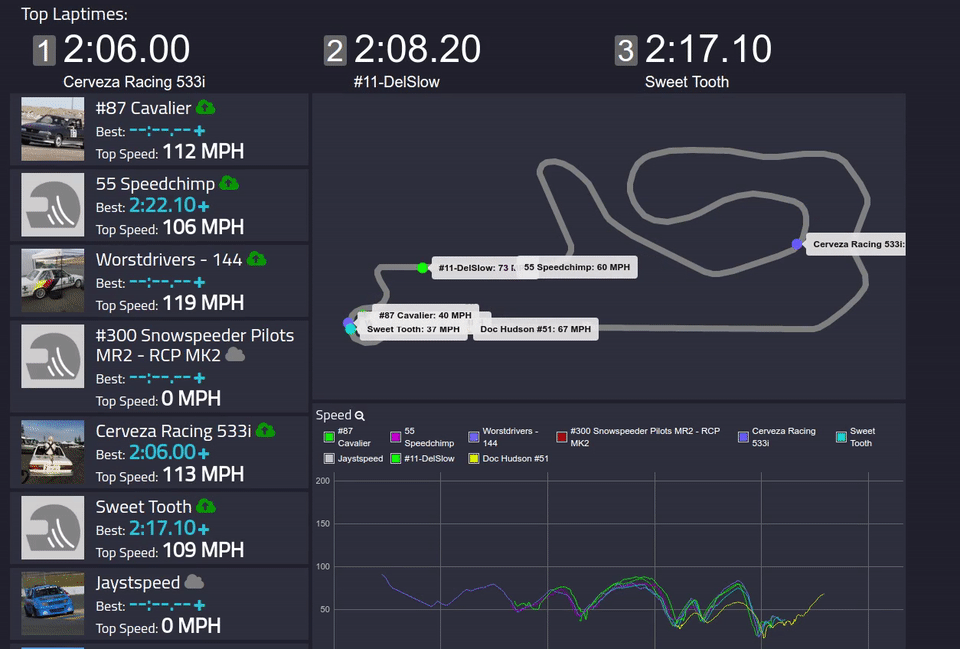 " width="640"/>
" width="640"/>
Enabling Telemetry
- Create an account on Podium and create a device ID.
- Enter the provided device ID into the telemetry configuration page of your RaceCapture app
- Enable the telemetry option in the top level application preferences.
Diagnostic Logs
To view the log messages provided by the RaceCapture unit, you can enable the Poll log check box. You can copy the current log to the clipboard by pressing the Copy button.
- Note: These logs are useful for diagnosing issues with your RaceCapture unit.
XXXXXXXXXXXXXXXXXXXXXXXXXXXXXXXXXXXXXXXXXXXXXXXXXXXXXXXXXXXXXXXXXXXXXXXX
The RaceCapture/Pro V2 firmware and app represents a major upgrade to the capabilities of the original RaceCapture/Pro system.
Currently supported platforms:
- Windows: currently supported
- Linux: currently supported by running from source
- OSX - beta support
Planned support:
- Android: Beta available, contact us a [email protected] for access
- iOS
Downloads
Get the latest firmware and app from the Downloads Page
Features
Check out some kickass features:
Multi-Platform, touch oriented application
Capable of running on Windows and Android, the new RaceCapture app will ultimately combine RaceAnalyzer and the current Mobile app into a unified configuration, dashboard and analysis solution.
Automatic Track Detection and configuration
The RaceCapture/Pro firmware supports automatic track detection and configuration, supporting up to 40 of your favorite race tracks.
When RaceCapture/Pro is powered up and GPS locks on, the system searches for a track within a 2 mile radius. If one is found, the start/finish line and sector points are automatically configured, enabling lap, sector and predictive timing features without having to alter configuration.
The latest race track configurations can be automatically downloaded and synchronized from http://www.race-capture.com via the application. If your track is not in the list, email us at [email protected] and we will work to get it added.
Automatic configuration can still be disabled and manual start/finish and sector points can be defined.
Manual Track Configuration
You can manually specify start/finish lines for custom track configurations.
- On the Race Track sectors page set Automatic Track Detection to Off
- For circuit type racing, set Separate start and finish lines to Off
- Click on the gear icon to the right of the Start/Finish configuration line
- Minimum Configuration
- Set the latitude / longitude point of the start finish line in the Start/Finish section
- Sector Configuration
- Set additional sector points ordered in the direction of travel on the track.
Multi-Sector Timing
We've expanded timing from a single split point to up to 20 sectors, enabling true sector based timing. The sector timing information are exposed as two additional channels:
- sectorTime - indicates the time of the last completed sector
- sector - indicates the last completed sector
Separate Start/Finish Lines
To enable auto-x/rally/hillclimb scenarios we've enabled the ability to define a separate start and finish line.
The beginning of a lap is triggered by the combination of a start point which defines the general area where the race car is staged, and a launch detection algorithm combining a speed and g-force delta threshold.
The completion of a lap is detected using the conventional GPS target detection mechanism.
Predictive Lap Timing
A new predictive lap timing algorithm augments current 'lapTime' channel with a new channel called 'predTime'.
Once a lap is completed, the data is used as a model to predict the next, ongoing lap. The predicted time sample rate is configurable up to the native GPS data rate.
CAN bus expansion
A single CAN bus channel is supported using the CANx expansion module, which plugs in to the expansion port next to the green terminal block.
The CAN feature can be configured with a variety of standard baud rates.
CAN send and receive commands are made available via Lua scripting and can be combined with the Virtual Channel feature.
OBD2 support
Enabled via the CANx module, standard OB2 PIDs can be queried and mapped to RaceCapture channels along with other sensors.
Due to the design of the OBD2 protocol, individual channels (PIDs) are requested sequentially, so individual channel rates decrease based on the number of channels enabled.
Virtual Channels
A virtual channel (aka 'Math channel') can be used to derive new channels from existing channel values. Examples include:
- Detecting gear based on RPM and speed ratios
- Turbo intercooler efficiency by calculating the difference between inlet and outlet temperature probes
- A calculated 'engine load' indicator by integrating RPM + Manifold Pressure Sensor value.
Lua Scripting
Lua Scripting stability, error recovery and logging has been improved.
- Use the print() and println() to print out log messages which will show up in the scripting view. Great for debugging.
- If a wayward script somehow crashes the firmware, the RCP watchdog will fire and start up RCP in safe mode, illuminating the red LED and bypassing script execution. Then, you'll have a chance to make fixes.
- Functions have been streamlined and normalized for consistency. Additional Lua functions have been added to support virtual channels, OBDII and CAN bus messaging.
Read more in our Lua Scripting Guide
Improved log timing accuracy
The core sample rate tick is now derived directly from the system's crystal-backed oscillator, making log file sample rates much more accurate.
Installation
Note, installation of the V2 firmware will disable the configuration functions of RaceAnalyzer. You will still be able to use analyze data from the RaceCapture/Pro log files until the analysis features are ported over to the new app.
Before continuing, save your old RaceCapture/Pro configuration to preserve any sensor calibration data. You will need this later when re-entering the calibration data into the new app
- Note, Due to the significant changes in the firmware, the RaceCapture .rcap configuration files are not compatible with the new configuration file format
Application
Install the RaceCapture app after downloading the setup package from the downloads section
Running
The RaceCapture app will search for a compatible RaceCapture/Pro on all of the available ports. If it is found, the configuration will be automatically read.
Editing Configuration
You can edit the RaceCapture/Pro configuration by entering the configuration view by touching the top level icon or accessing the sidebar menu.
Reading / Writing / Saving / Opening configuration
Use the icons in the lower left of the configuration view to read / write configuration data from the controller as well as save / load configuration files.
When reading the configuration, the progress bar at the top will show activity. After making a change, be sure to write back the configuration to RaceCapture/Pro.
Auto track detection
To enable automatic track detection and configuration, select the Race Track / Sectors option in the left menu. Touch the "+" icon at the bottom to select tracks to add.
- Note: For the first time running you will need to download the latest set of race tracks by touching the cloud icon in the lower right corner of the app.
Search for your favorite tracks by name and add them to the list.
GPS Configuration
You can select a common sample rate for GPS related channels, up to the limit of the sensor (10Hz).
- Note: Leave the Position, Speed, Distance, and Time of Day channels enabled for accurate analysis.
Analog Channels
Configure analog sensors using this view.
Enable a channel by selecting a channel name and sample rate, then configure the mapping scheme:
- Raw value
- Simple linear scaling
- Interpolated map
Most sensors are configured in map mode to compensate for non-linear response, like many temperature sensors.
- Note Channel #8 is fixed as a battery input channel and should not be changed.
Pulse/RPM Sensors
Configure RPM / Timer / pulse channels using this view.
Enable a channel by selecting a channel name and sample rate, then configure the channel options:
- Channel Operation Mode: RPM, frequency, or pulse period
- Clock divider: This specifies the operating range for measuring the pulse. This is typically left at 128.
- Pulse Per Revolution / Teeth Per Wheel: This specifies the number of pulses representing a complete revolution of the wheel.
- For RPM mode This value is typically set based on the number of cylinders and the number of coil packs used on the engine
Digital In/Out
Configure the 3 digital input / output channels using this view:
Enable a channel by selecting a channel name and sample rate, then configure the channel options:
- Mode: Set the channel to input for reading digital on/off sensors, or output to use the channel in output mode to control a device.
Accelerometer/Gyro
Configure the Accelerometer / Gyro with this view. Edit channel mappings, orientation and zero levels.
Pulse/Analog Out
Up to 4 PWM / analog output channels are available for controlling devices - LEDs, motors - or sending signals to other systems.
Enable a channel by selecting the channel name and sample rate, then configure the channel options:
- Output Mode Select either Frequency / Pulse Width Modulated (PWM) mode or analog output mode. MK1 only: to enable analog mode you also need to flip the hardware dip switch on the RaceCapture/Pro main board.
- Logging Mode Select either logging the frequency or the analog output voltage.
- Startup Duty Cycle The default duty cycle when the system starts up.
- Startup Period The default startup value for the pulse period. A larger number means individual pulses are spread further apart.
CAN Bus
Enable the CAN bus interface and baud rate using this screen.
OBD II
You can create OBDII channels and query standard OBD2 PIDs over a compatible OBD2 CAN bus link.
Note OBD2 is only supported for ECUs that support the CAN bus protocol. The mandatory requirement for CAN support is 2008, but some vehicles implemented it earlier. Research your year/make/model to confirm.
To add an OBD2 channel, click the + sign at the bottom of this configuration page and select the channel you wish to log.
Important The sample rate you select is the logged sample rate, not the actual sample rate of the data. Due to the limitations of the OBDII protocol, channels are queried sequentially in a request/reply fashion. Therefore, as more channels are enabled the effective individual channel sample rate is reduced.

